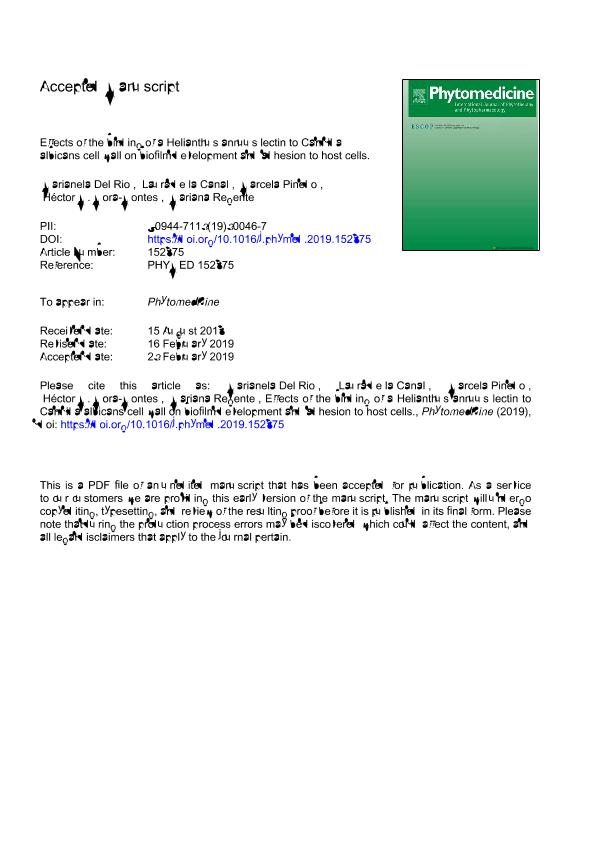Mostrar el registro sencillo del ítem
dc.contributor.author
del Rio, Marianela Victoria

dc.contributor.author
de la Canal, Laura

dc.contributor.author
Pinedo, Marcela Lilian

dc.contributor.author
Mora Montes, Héctor M.
dc.contributor.author
Regente, Mariana Clelia

dc.date.available
2020-04-24T15:41:37Z
dc.date.issued
2019-05
dc.identifier.citation
del Rio, Marianela Victoria; de la Canal, Laura; Pinedo, Marcela Lilian; Mora Montes, Héctor M.; Regente, Mariana Clelia; Effects of the binding of a Helianthus annuus lectin to Candida albicans cell wall on biofilm development and adhesion to host cells; Elsevier Gmbh; Phytomedicine; 58; 5-2019; 1-38
dc.identifier.issn
0944-7113
dc.identifier.uri
http://hdl.handle.net/11336/103543
dc.description.abstract
Background: In our previous study, we isolated and characterized a lectin called Helja from Helianthus annuus (sunflower) and then, in a further study, demonstrated its antifungal activity against Candida spp. Since Candida infections are a major health concern due to the increasing emergence of antifungal resistant strains, the search for new antifungal agents offers a promising opportunity for improving the treatment strategies against candidiasis. Purpose: The aim of this work was to get insights about the mechanism of action of Helja, an antifungal lectin of H. annuus, and to explore its ability to inhibit Candida albicans biofilm development and adherence to buccal epithelial cells (BEC). Study design/methods: Yeast viability was evaluated by Evans Blue uptake and counting of colony forming units (CFU). The yeast cell integrity was assessed using Calcofluor White (CFW) as a cell wall perturbing agent and sorbitol as osmotic protectant. The induction of oxidative stress was evaluated using 3,3′-diaminobenzidine (DAB) for detection of hydrogen peroxide. The adherence was determined by counting the yeast cells attached to BEC after methylene blue staining. The biofilms were developed on polystyrene microplates, visualized by confocal laser scanning microscopy and the viable biomass was quantified by CFU counting. The binding lectin-Candida was assessed using Helja conjugated to fluorescein isothiocyanate (Helja-FITC) and simultaneous staining with CFW. The cellular surface hydrophobicity (CSH) was determined using a microbial adhesion to hydrocarbons method. Results: C. albicans cells treated with 0.1 µg/µl of Helja showed a drastic decrease in yeast survival. The lectin affected the fungal cell integrity, induced the production of hydrogen peroxide and inhibited the morphological transition from yeast to filamentous forms. Helja caused a significant reduction of adherent cells and a decrease in biofilm biomass and coverage area. The treatment with the protein also reduced the surface hydrophobicity of fungal cells. We show the binding of Helja-FITC to yeast cells distributed as a thin outer layer to the CFW signal, and this interaction was displaced by mannose and Concanavalin A. Conclusion: The results demonstrate the interaction of Helja with the mannoproteins of C. albicans cell wall, the disruption of the cell integrity, the induction of oxidative stress, the inhibition of the morphological transition from yeast to filamentous forms and the fungal cell viability loss. The binding Helja-Candida also provides a possible explanation of the lectin effect on cell adherence, biofilm development and CSH, relevant features related to virulence of the pathogen.
dc.format
application/pdf
dc.language.iso
eng
dc.publisher
Elsevier Gmbh

dc.rights
info:eu-repo/semantics/openAccess
dc.rights.uri
https://creativecommons.org/licenses/by-nc-nd/2.5/ar/
dc.subject
ADHERENCE
dc.subject
ANTIFUNGAL LECTIN
dc.subject
BIOFILM
dc.subject
CANDIDA
dc.subject
CELL WALL
dc.subject
JACALIN
dc.subject.classification
Biología Celular, Microbiología

dc.subject.classification
Ciencias Biológicas

dc.subject.classification
CIENCIAS NATURALES Y EXACTAS

dc.title
Effects of the binding of a Helianthus annuus lectin to Candida albicans cell wall on biofilm development and adhesion to host cells
dc.type
info:eu-repo/semantics/article
dc.type
info:ar-repo/semantics/artículo
dc.type
info:eu-repo/semantics/publishedVersion
dc.date.updated
2020-04-23T19:26:31Z
dc.journal.volume
58
dc.journal.pagination
1-38
dc.journal.pais
Alemania

dc.description.fil
Fil: del Rio, Marianela Victoria. Consejo Nacional de Investigaciones Científicas y Técnicas. Centro Científico Tecnológico Conicet - Mar del Plata. Instituto de Investigaciones Biológicas. Universidad Nacional de Mar del Plata. Facultad de Ciencias Exactas y Naturales. Instituto de Investigaciones Biológicas; Argentina
dc.description.fil
Fil: de la Canal, Laura. Consejo Nacional de Investigaciones Científicas y Técnicas. Centro Científico Tecnológico Conicet - Mar del Plata. Instituto de Investigaciones Biológicas. Universidad Nacional de Mar del Plata. Facultad de Ciencias Exactas y Naturales. Instituto de Investigaciones Biológicas; Argentina
dc.description.fil
Fil: Pinedo, Marcela Lilian. Consejo Nacional de Investigaciones Científicas y Técnicas. Centro Científico Tecnológico Conicet - Mar del Plata. Instituto de Investigaciones Biológicas. Universidad Nacional de Mar del Plata. Facultad de Ciencias Exactas y Naturales. Instituto de Investigaciones Biológicas; Argentina
dc.description.fil
Fil: Mora Montes, Héctor M.. Universidad de Guanajuato; México
dc.description.fil
Fil: Regente, Mariana Clelia. Consejo Nacional de Investigaciones Científicas y Técnicas. Centro Científico Tecnológico Conicet - Mar del Plata. Instituto de Investigaciones Biológicas. Universidad Nacional de Mar del Plata. Facultad de Ciencias Exactas y Naturales. Instituto de Investigaciones Biológicas; Argentina
dc.journal.title
Phytomedicine

dc.relation.alternativeid
info:eu-repo/semantics/altIdentifier/url/https://www.sciencedirect.com/science/article/abs/pii/S0944711319300467
dc.relation.alternativeid
info:eu-repo/semantics/altIdentifier/doi/http://dx.doi.org/10.1016/j.phymed.2019.152875
Archivos asociados
